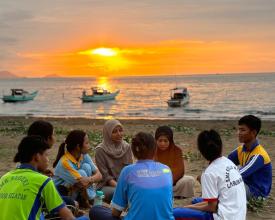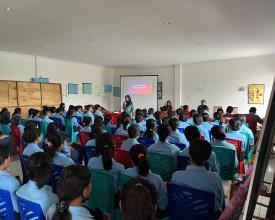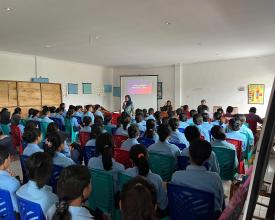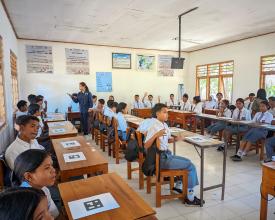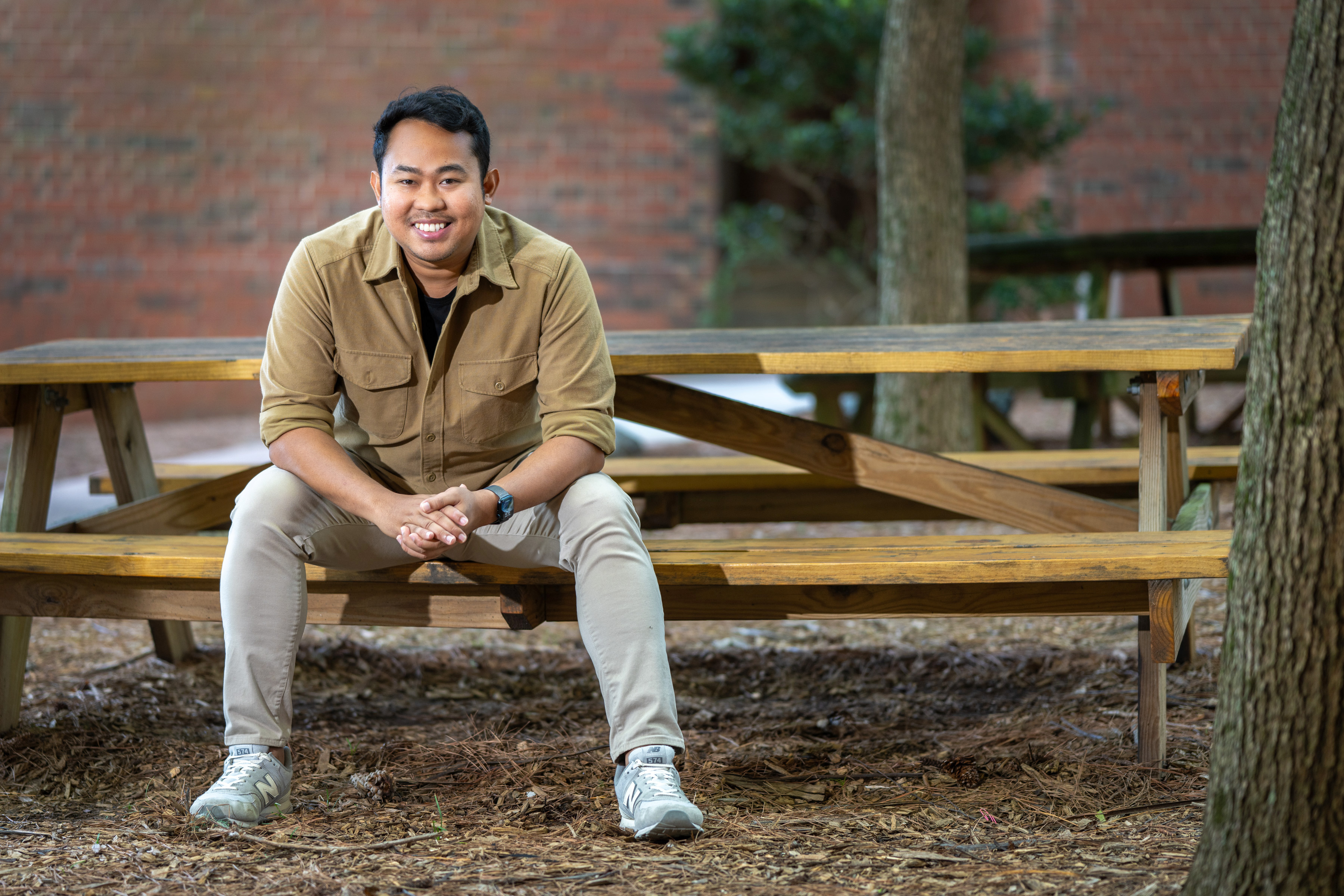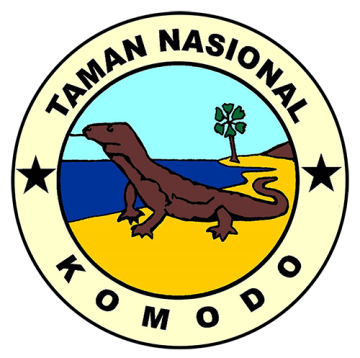
A Park-Led Conservation Education Model: Ranger Goes to School in Komodo National Park
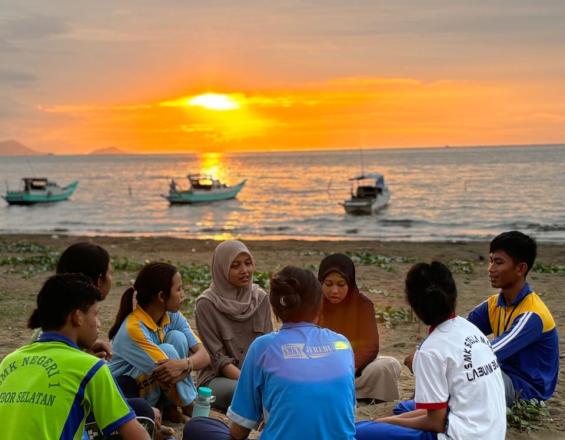
Ranger Goes to School (RGTS) is a ranger-led, school-based conservation education initiative developed by Komodo National Park to inspire high school students in Labuan Bajo—the gateway to the park—to become future stewards of nature. Founded by senior park ranger Muhammad Ikbal Putera, RGTS addresses the growing disconnect between youth and their environment through experiential learning, storytelling, and the use of accessible technology. Since 2022, the program has reached over 1,000 students across five high schools. RGTS blends classroom and outdoor settings using tools such as PictureThis for plant identification, Canva for creating student presentations, and Kahoot for interactive quizzes. Drones capture stunning aerial footage that is transformed into documentary films to build emotional connections with the park, while social media extends the program’s reach and visibility. These technologies not only enrich the learning experience but also strengthen students’ sense of place and commitment to conservation.
Context
Challenges addressed
The Ranger Goes to School (RGTS) program addresses critical environmental, social, and economic challenges affecting Komodo National Park and its surrounding communities.
- Environmental: The park faces increasing ecological pressure from over-tourism and destructive fishing. RGTS equips youth with ecological knowledge—what inhabits the park, how it's managed, and why it must be protected—not only for humans but for all species. This fosters ecological empathy and supports human–wildlife coexistence.
- Social: Local youth often see the park primarily as a tourism site rather than a living natural heritage. RGTS reorients this perception by fostering a sense of place, local pride, and belonging. Students begin to see themselves as caretakers of a globally significant ecosystem.
- Economic: Many communities rely on unsustainable resource use for income. RGTS graduates gain conservation knowledge and a certificate of accomplishment, which strengthens their eligibility for scholarships, higher education, or jobs linked to sustainable tou
Location
Process
Summary of the process
The building blocks of Ranger Goes to School (RGTS) form a cohesive and reinforcing framework. At its heart is youth conservation education and engagement, which builds ecological literacy, awareness, and leadership potential. This is deepened through place attachment—cultivated via storytelling, experiential learning, and direct exposure to Komodo National Park’s biodiversity—shifting perceptions of the park from a tourist site to a source of pride and identity. Technology integration strengthens learning: apps like PictureThis enable real-time plant ID, while drone footage and camera trap data make complex ecological topics engaging and accessible. Volunteer collaboration is central; a multidisciplinary team of rangers, educators, NGO professionals, and researchers co-develop and teach the curriculum. Lessons are grounded in real-world conservation through ecological and social data use. Institutional partnerships with schools, NGOs, universities, and local authorities ensure reach, community support, and long-term viability. Together, these elements create a scalable model to empower youth as conservation leaders.
Building Blocks
Empowering Youth through Conservation Education: The Ranger Goes to School (RGTS) Program
The Ranger Goes to School (RGTS) program is an innovative conservation education initiative designed to inspire high school students in Labuan Bajo to become future stewards of nature. Created by Muhammad Ikbal Putera, a senior park ranger at Komodo National Park, and led by the park’s dedicated rangers, RGTS bridges the gap between youth and nature by fostering environmental stewardship, wildlife conservation, and sustainable living through interactive, hands-on learning experiences. By leveraging the unique biodiversity and ecosystems of Komodo National Park, RGTS provides students with a real-world context for understanding conservation challenges and solutions, encouraging them to develop a lifelong commitment to protecting the environment. With its scalable approach and adaptable framework, RGTS has the potential to serve as a global model for conservation education in national parks, inspiring young people worldwide to value and safeguard their local natural heritage.
Key Building Blocks
- Youth Education and Engagement:
RGTS empowers high school students in Labuan Bajo through interactive lessons in environmental stewardship, wildlife conservation, and sustainable living. These sessions raise awareness about ecological challenges caused by tourism and teach students how to protect biodiversity. The program equips the next generation with the knowledge and motivation to advocate for sustainability, offering a model that can be replicated in other regions. - Place Attachment Development:
Through immersive activities, such as field excursions and direct engagement with Komodo National Park’s ecosystems, RGTS fosters strong emotional and intellectual bonds between students and nature. This connection inspires pride and responsibility for local environments, a universal principle that can enhance conservation efforts across national parks globally. - Technology Integration:
Tools like plant identification apps, drone footage, and camera trap data enhance the learning experience by making ecological concepts tangible and relatable. This use of technology enriches education while preparing students for future professional roles, showcasing an innovative method that can be adapted in other conservation programs. - Volunteer Collaboration:
Contributions from park rangers, educators, and conservation practitioners ensure a community-driven approach. Their diverse expertise strengthens the program and provides a blueprint for engaging local talent and expertise in conservation education initiatives worldwide. - Ecological and Social Data Utilization:
Lessons are grounded in real-world examples using data from Komodo National Park. This approach connects students to pressing ecological issues like tourism impacts on wildlife and ecosystems. Other national parks can adopt this model by integrating their unique ecological and cultural data into similar programs. - Economic Pathways:
RGTS goes beyond education by providing students with certificates upon program completion, supporting applications for internships and higher education. In the long term, graduates may return to their communities as park rangers or environmentally conscious professionals, contributing to sustainable governance. This economic pathway can inspire similar initiatives in national parks globally to strengthen conservation leadership.
Impact
Since its launch in 2022, RGTS has taught more than 1,000 high school students, addressing critical environmental, social, and economic challenges. It combats the disconnect between youth and nature, fosters a pipeline of future conservation leaders, and promotes shared responsibility for protecting Komodo National Park’s natural heritage. By empowering students to understand biodiversity’s value and sustainable living, RGTS is laying the foundation for long-term conservation advocacy and community support. As a scalable model, RGTS offers a framework that national parks worldwide can adopt and adapt. By engaging local youth, fostering place attachment, and integrating modern technology and education, RGTS demonstrates how conservation education can inspire the next generation to protect their unique environments and contribute to global sustainability.
Enabling factors
- Supportive Partnerships:
The program thrives on strong collaborations with local schools and government agencies, enabling seamless integration into the curriculum, consistent access to students, and logistical support for field-based activities. Partnerships with universities and NGOs contribute cutting-edge research insights, educational resources, and volunteer support, elevating the program’s quality and reach. The RGTS program has also garnered regional attention, with the Provincial Government of East Nusa Tenggara expressing interest in making it a mandatory local content course for all students in the province. However, Komodo National Park envisions RGTS as mandatory specifically for students in Labuan Bajo, West Manggarai Regency, to serve as a model for other regions in East Nusa Tenggara and beyond. - Dedicated Contributors:
RGTS is powered by a passionate team of park rangers, educators, and conservation practitioners who bring a wealth of expertise and enthusiasm. Their commitment to delivering engaging, hands-on lessons ensures high-quality education that resonates with students. As role models, they inspire participants to view conservation as a fulfilling and achievable career path. - Technology Integration:
Modern tools such as plant identification apps, drone footage, and camera trap data bring conservation education to life. These technologies allow students to interact with ecological data in innovative ways, making complex concepts more accessible while exposing them to professional conservation methodologies. - Unique Biodiversity:
The unparalleled biodiversity and cultural significance of Komodo National Park provide an extraordinary backdrop for RGTS. Students are immersed in real-world conservation challenges, such as protecting the iconic Komodo dragon, which fosters a deep emotional and intellectual connection to their natural environment. Data from ongoing park research enhances lessons with relevance and authenticity. - Community Support:
The enthusiastic involvement of parents, local leaders, and stakeholders in Labuan Bajo underscores the program’s importance to the community. This support encourages student participation, builds trust, and ensures the program aligns with local needs and values, reinforcing its long-term sustainability. - Recognition and Scaling Potential:
RGTS has received significant recognition regionally and internationally. It has been presented at prestigious platforms such as the 2nd Asia Parks Congress and UNESCO conferences, where it was highlighted as an innovative, ranger-led initiative for youth education. This attention not only signals positive feedback but also showcases RGTS as a rare example of how park rangers can drive meaningful educational innovation. Such recognition further supports the program’s scalability, signaling its potential to be adopted by other provinces in Indonesia and national parks worldwide.
Lesson learned
The Ranger Goes to School (RGTS) program has provided key insights into the role of conservation education in addressing environmental challenges, fostering human-behavior change, and equipping the next generation with the tools to protect biodiversity and combat climate change. Several lesson learned of this program are as follow:
1. Linking Local Conservation to Global Challenges
- Tailoring lessons to local issues like habitat degradation and biodiversity loss makes the program relatable, while connecting them to global challenges like climate change adds urgency and relevance.
- Students understand how local actions, such as reducing waste and promoting sustainable tourism, contribute to global environmental goals.
2. The Power of Immersive Learning
- Field excursions and real-world experiences foster deeper understanding and retention of ecological concepts.
- Tools like drones, plant identification apps, and camera traps enhance engagement, making complex issues such as climate change and ecosystem dynamics tangible and relatable.
3. Inspiring Human-Behavior Change
- Community-driven education builds a ripple effect, where students’ conservation efforts are reinforced by parents, educators, and local leaders.
- The program emphasizes actionable steps, such as reducing plastic use, that empower students to make meaningful contributions.
4. Building a Conservation Workforce
- The program encourages students to consider careers as park rangers or conservation practitioners, addressing the need for more skilled professionals in the field.
- Certificates awarded to participants open pathways to internships and higher education, creating a pipeline of conservation-minded graduates who may return to Labuan Bajo to support Komodo National Park.
5. Scaling Potential
- The program’s success has drawn regional interest, with the Provincial Government of East Nusa Tenggara considering RGTS as a mandatory course for all students in the province.
- International recognition at forums such as the 2nd Asia Parks Congress and UNESCO conferences highlights its scalability as a model for conservation education globally.
6. Addressing Climate Change Through Education
- Lessons on the role of ecosystems like mangroves and coral reefs in climate resilience teach students about the interconnectedness of environmental and societal well-being.
- By integrating climate change education into the program, RGTS prepares students to face and mitigate future environmental challenges.
Lessons Learned from Park Rangers. The team teachers (park rangers and practitioners) leading the RGTS program have gained valuable insights into their evolving role as educators, conservation leaders, and community advocates. Some of the lesson learned from our perspectives are:
1. Expanding Roles Beyond Conservation
- Park rangers have learned to adapt their skills to include education and community engagement, demonstrating the importance of their presence as role models for youth.
- By stepping into teaching roles, rangers bridge the gap between fieldwork and public understanding, showing that conservation is a shared responsibility.
2. Leveraging Local Knowledge
- Rangers’ deep understanding of Komodo National Park’s ecosystems and challenges enables them to provide authentic, impactful lessons to students.
- Sharing their experiences, such as monitoring Komodo dragons or mitigating human-wildlife conflicts, adds credibility and inspires students to value their contributions.
3. Building Leadership and Communication Skills
- The program has enhanced rangers’ abilities to communicate complex ecological and conservation concepts effectively to diverse audiences, including youth and community leaders.
- Leading RGTS has positioned rangers as trusted voices in the community, strengthening relationships and fostering local buy-in for conservation efforts.
4. Addressing the Need for More Rangers
- RGTS has underscored the need to inspire and train the next generation of park rangers. Students who interact with rangers through the program are more likely to consider conservation careers, addressing the workforce gap in this critical field.
5. Highlighting the Role of Rangers Globally
- Presenting RGTS at international forums has showcased the unique contributions of park rangers as drivers of innovation in conservation education. This recognition positions rangers not only as protectors of biodiversity but also as educators and global ambassadors for conservation.
6. Promoting Collaboration and Professional Growth
- Collaborating with educators, NGOs, and local leaders has expanded rangers’ professional networks and enriched their perspectives on interdisciplinary approaches to conservation.
- These collaborations reinforce the idea that rangers are integral to building holistic, community-driven conservation solutions.
Conclusion
The lessons learned from the RGTS program and its park ranger leaders highlight the importance of education and collaboration in addressing environmental challenges. While RGTS demonstrates how tailored conservation education can inspire youth and drive behavioral change, the experiences of park rangers underscore their pivotal role as educators, leaders, and advocates in fostering a sustainable future. Together, these insights reinforce the need for scalable, community-driven solutions to combat climate change and protect biodiversity worldwide.
Connecting with Komodo: Building Place Attachment for Conservation Leadership
This building block focuses on cultivating place attachment—an emotional, cultural, and cognitive bond between youth and Komodo National Park. Through storytelling, field immersion, and reflective learning, students begin to see the park not just as a tourist destination, but as a vital part of their identity and future. The program employs experiential tools such as ranger-led nature walks, local legends, visual storytelling, and ecological mapping to foster deeper connections with the landscape and its inhabitants. These experiences help reposition the park from a backdrop of economic activity into a living, shared heritage. As students develop a sense of belonging and pride, their motivation to protect and advocate for the environment increases. This shift is crucial in transforming passive knowledge into active stewardship, inspiring long-term behavioral change and conservation leadership. Building place attachment ensures that youth understand both the ecological and emotional value of the park, anchoring their sense of responsibility in a place they call home.
Enabling factors
Key enablers include the presence of committed park rangers who serve as mentors, local legends and cultural narratives that resonate with students, and access to Komodo National Park as an outdoor classroom. Collaborative partnerships with schools ensure curricular alignment and logistical support. The trust built between students and facilitators, paired with immersive activities in nature, significantly enhances students’ emotional connection to the park and their willingness to become stewards.
Lesson learned
One powerful lesson is that connection precedes conservation. Students are more likely to care for and protect a place they feel emotionally and culturally bonded to. We also learned that place attachment cannot be forced—it must be earned through authentic, meaningful experiences. Building trust between facilitators and students takes time but is essential for success. Another insight is the importance of cultural relevance: stories, language, and examples drawn from local contexts deepen resonance and memory. Finally, place attachment is not only about nostalgia or pride—it can be a powerful driver for transformation. When students feel ownership of Komodo National Park, they begin to see conservation not as someone else’s job, but as a personal responsibility. This shift is what transforms students from observers into advocates, and classrooms into launchpads for future conservation leaders.
Impacts
The integration of technology into the Ranger Goes to School (RGTS) program has generated measurable environmental, social, and economic benefits for the people and ecosystems of Labuan Bajo. Tools such as plant ID apps, drone footage, and camera trap data have transformed conservation education into a practical, engaging experience rooted in local ecological realities.
Environmental Impact:
Camera trap and drone visuals help students observe Komodo dragon behavior, ecosystem changes, and biodiversity patterns. These tools make invisible ecological dynamics visible, reinforcing the importance of protecting Komodo National Park as a living World Heritage Site.
Social Impact:
Since 2022, RGTS has reached over 1,000 students in four high schools. The program improves environmental literacy and instills pride in Komodo’s natural heritage. Students begin to view rangers as role models and see conservation not as abstract science, but as a meaningful part of their identity.
Economic Impact:
Graduates receive certificates that support access to internships, scholarships, and local job opportunities. This helps reduce youth unemployment while building a future workforce committed to sustainable tourism and conservation. In this way, RGTS bridges education, technology, and livelihoods—empowering communities from the classroom to the forest.
Beneficiaries
Beneficiaries include over 1,000 students and five schools in Labuan Bajo, whose environmental literacy and future career prospects are enhanced. The Provincial Government of NTT gains a scalable education model. Komodo National Park secures its future steward
Additionally, explain the scalability potential of your Solution. Can it be replicated or expanded to other regions or ecosystem?
The Ranger Goes to School (RGTS) model is highly scalable and adaptable to other regions and ecosystems. Its blend of technology, conservation education, and community-driven implementation offers a replicable framework for national parks globally. With place-based storytelling and ecosystem-specific content, RGTS can be tailored to local biodiversity and cultural contexts.
Successful replication depends on several factors. Chiefly, it requires a dedicated team—rangers, educators, and practitioners—committed to program leadership and adaptation. The model also works best when adopted as a formal local content subject, rather than a substitute for standard teaching. This ensures the program enhances rather than replaces core education.
With strong partnerships among schools, government agencies, and conservation actors, RGTS can empower youth across regions to connect with their natural heritage, while building local capacity for conservation leadership. Its impact in Komodo offers a promising foundation for broader implementation.
Global Biodiversity Framework (GBF)
Sustainable Development Goals
Story

The Ranger Goes to School (RGTS) program is rooted in my experience as a park ranger witnessing a quiet crisis—young people growing up next to Komodo National Park without truly knowing it. Despite living near a UNESCO World Heritage Site, many students in Labuan Bajo saw the park as something meant for tourists, not as part of their own lives or future.
This realization became personal after a conversation with a cleaning staff member. She shared how hard she worked to support her children’s education, only to see them uncertain about their future. They had no connection to the very landscape that surrounded them.
That moment sparked the beginning of RGTS—a ranger-led, school-based conservation education program aimed not just at teaching students, but at transforming how they see themselves in relation to the park. We didn’t start with a large budget or institutional framework. We started with 14 park rangers who believed in the mission and volunteered their time.
Since then, that team has grown organically to 29 individuals—including teachers, conservationists, NGO workers, and government staff—who now co-develop and co-deliver the program. And the number continues to grow, as more people recognize the importance of reconnecting youth with their natural heritage.
What makes this model powerful is its authenticity. It is led by those who protect the park and grounded in the classrooms where local identity is shaped. Students are not just learning facts—they are being invited into the living story of Komodo.
The transformation is visible. Students who once viewed the park from a distance now speak of it with pride. Some have gone on to apply for conservation internships, scholarships, and higher education. One student told me, “Before RGTS, I thought the dragons were only for tourists. Now I feel like they are part of who we are.”
Through this journey, we’ve learned that even a single conversation can spark something greater—and that one person, willing to act, can start a movement when joined by others. RGTS is more than a program. It is proof that empowering youth through locally led education can build the next generation of conservation leaders—rooted in place, pride, and purpose.


